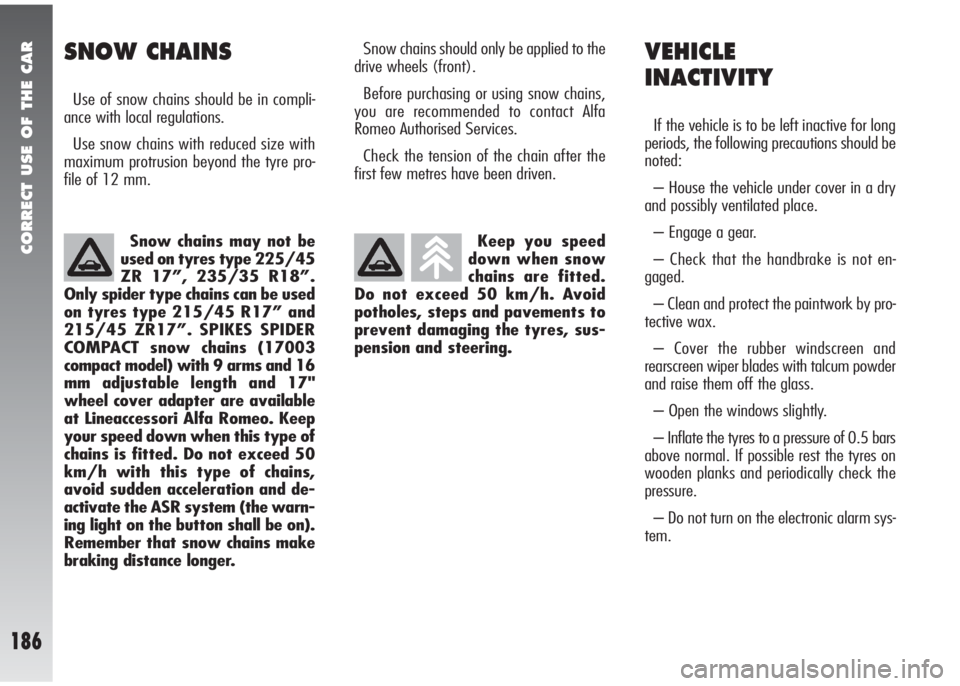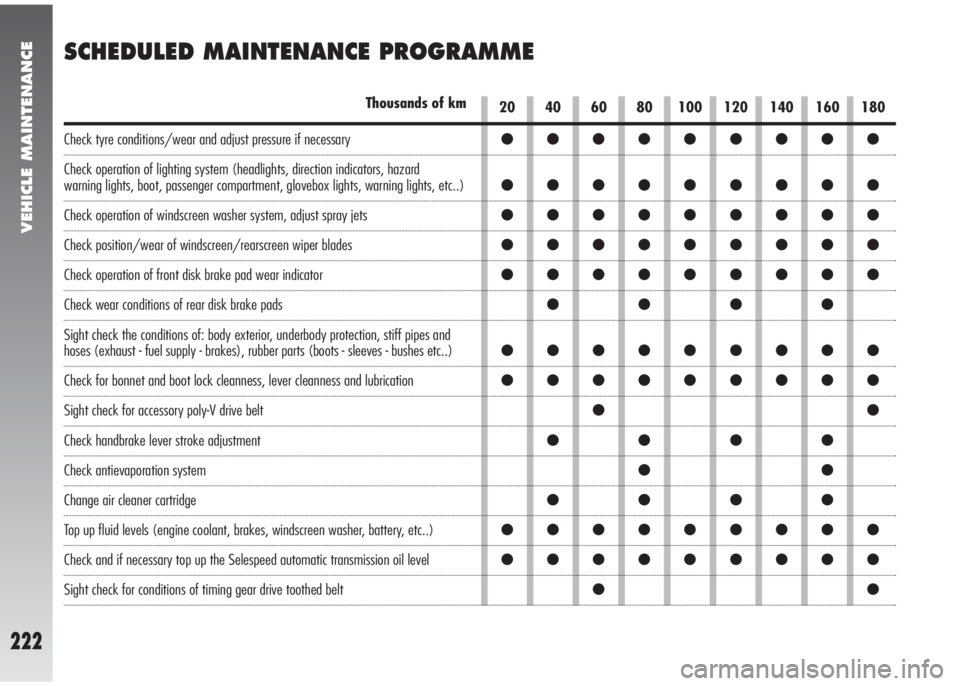2009 Alfa Romeo 147 brake light
[x] Cancel search: brake lightPage 188 of 291

CORRECT USE OF THE CAR
186
VEHICLE
INACTIVITY
If the vehicle is to be left inactive for long
periods, the following precautions should be
noted:
– House the vehicle under cover in a dry
and possibly ventilated place.
– Engage a gear.
– Check that the handbrake is not en-
gaged.
– Clean and protect the paintwork by pro-
tective wax.
– Cover the rubber windscreen and
rearscreen wiper blades with talcum powder
and raise them off the glass.
– Open the windows slightly.
– Inflate the tyres to a pressure of 0.5 bars
above normal. If possible rest the tyres on
wooden planks and periodically check the
pressure.
– Do not turn on the electronic alarm sys-
tem. Keep you speed
down when snow
chains are fitted.
Do not exceed 50 km/h. Avoid
potholes, steps and pavements to
prevent damaging the tyres, sus-
pension and steering.
Snow chains should only be applied to the
drive wheels (front).
Before purchasing or using snow chains,
you are recommended to contact Alfa
Romeo Authorised Services.
Check the tension of the chain after the
first few metres have been driven.SNOW CHAINS
Use of snow chains should be in compli-
ance with local regulations.
Use snow chains with reduced size with
maximum protrusion beyond the tyre pro-
file of 12 mm.
Snow chains may not be
used on tyres type 225/45
ZR 17”, 235/35 R18”.
Only spider type chains can be used
on tyres type 215/45 R17” and
215/45 ZR17”. SPIKES SPIDER
COMPACT snow chains (17003
compact model) with 9 arms and 16
mm adjustable length and 17"
wheel cover adapter are available
at Lineaccessori Alfa Romeo. Keep
your speed down when this type of
chains is fitted. Do not exceed 50
km/h with this type of chains,
avoid sudden acceleration and de-
activate the ASR system (the warn-
ing light on the button shall be on).
Remember that snow chains make
braking distance longer.
Page 192 of 291

IN AN EMERGENCY
190
IMPORTANTThe car is equipped with
“Kit for tyre quick repair Fix&Go“, see the
instructions contained in the following chap-
ter.
STARTING BY INERTIAIN THE EVENT OF A PUNCTURE
Never push, tow or coast
start the vehicle. This could
cause fuel to flow into the
catalyst damaging it irreversibly.
Remember that the engine
brake and power steering
are not operational until the engine
is started, therefore, much greater
effort than usual is needed on the
brake pedal and steering wheel.
WARNING
Signal the presence of the
stationary vehicle according
to the current regulations: hazard
warning lights, reflecting triangle,
etc. Any passengersshould leave
the car.
WARNING
Should the type of wheels
used be changed (alloy
rims instead of steel), it is also nec-
essary to replace the complete kit
of fastening bolts with others of
suitable size.
WARNING
Page 195 of 291

IN AN EMERGENCY
193
INFLATING PROCEDURE
– Place the wheel in the position illustrated
in the figure (A-fig. 14) for the operation
with the valve, then engage the hand-
brake.
– Screw the filling pipe (B-fig. 15) to
the bottle (C).
– Unscrew the tyre valve plug, remove the
element inside the valve by using the ap-
propriate tool (D-fig. 16); be careful not
to place it on the sand or on a dirty surface.
– Introduce the filling pipe (B-fig. 17)
in the tyre valve, keep the bottle (C) with
the pipe directed downwards, then press the
bottle so that the whole sealer can get into
the tyre.– Screw again the element inside the
valve with the tool (D-fig. 18).
– Use the appropriate lever (E-fig. 19)
to insert and clamp the air compressor pipe
(F) to the tyre valve.
– Start the engine, insert the plug (G-
fig. 20) in the lighter (or current socket,
where fitted) and inflate the tyre according
to the right pressure value (see “Cold infla-
tion pressures” in the “Technical specifica-
tion”). You are advised to check the tyre
pressure value on the pressure gauge (H-
fig. 19) with the compressor off, in order
to have a more accurate reading.If it is not possible to reach the prescribed
pressure, move the car forwards or back-
wards for about 10 metres, so that the seal-
er is distributed inside the tyre, then repeat
inflation.
If, in spite of the last operation, the pre-
scribed pressure is not achieved, do not
move the vehicle and contact Alfa Romeo
Authorized Services.
Once the correct tyre pressure has been
reached, start driving immediately so that
the sealer is distributed evenly inside the
tyre.
fig. 14
A0A0447m
fig. 15
A0A0378m
fig. 16
A0A0448m
Page 224 of 291

●●●●●●●●●
●●●●●●●●●
●●●●●●●●●
●●●●●●●●●
●●●●●●●●●
●●●●
●●●●●●●●●
●●●●●●●●●
●●
●●●●
●●
●●●●
●●●●●●●●●
●●●●●●●●●
●●
VEHICLE MAINTENANCE
222
SCHEDULED MAINTENANCE PROGRAMME
20 40 60 80 100 120 140 160 180Thousands of km
Check tyre conditions/wear and adjust pressure if necessary
Check operation of lighting system (headlights, direction indicators, hazard
warning lights, boot, passenger compartment, glovebox lights, warning lights, etc..)
Check operation of windscreen washer system, adjust spray jets
Check position/wear of windscreen/rearscreen wiper blades
Check operation of front disk brake pad wear indicator
Check wear conditions of rear disk brake pads
Sight check the conditions of: body exterior, underbody protection, stiff pipes and
hoses (exhaust - fuel supply - brakes), rubber parts (boots - sleeves - bushes etc..)
Check for bonnet and boot lock cleanness, lever cleanness and lubrication
Sight check for accessory poly-V drive belt
Check handbrake lever stroke adjustment
Check antievaporation system
Change air cleaner cartridge
Top up fluid levels (engine coolant, brakes, windscreen washer, battery, etc..)
Check and if necessary top up the Selespeed automatic transmission oil level
Sight check for conditions of timing gear drive toothed belt
Page 226 of 291

VEHICLE MAINTENANCE
224
ADDITIONAL
OPERATIONS
Every 1000 kmor before long journeys,
check and if necessary top up:
– engine coolant fluid level
– brake/hydraulic clutch control fluid level
– power steering fluid level
– windscreen/rearscreen and headlamp
washer fluid level
– tyre pressure and conditions.
Every 3000 kmcheck and if necessary
top up the engine oil level.
The use of products of the FL Seleniais
recommended which have been designed
and made expressly for Alfa Romeo cars
(see “Refuelling” in the “Technical Specifi-
cations” chapter).
ANNUAL INSPECTION
PROGRAMME
For cars with an annual mileage
of below 20,000 km (for example
about 10,000 km) the following
yearly inspection programme is ad-
vised:
– Check tyre conditions/wear and if nec-
essary adjust the pressure
– Check operation of lighting system
(headlights, direction indicators, hazard
warning lights, boot, passenger compart-
ment, glovebox lights, warning lights )
– Check operation of windscreen wiper
system, spray jet adjustment
– Check position/wear of windscreen/
rearscreen wiper blades
– Check front disk brake pad conditions
and wear
– Check for bonnet and boot lock clean-
ness, lever cleanness and lubrication– Sight check for conditions of: engine,
gearbox, transmission, pipes (exhaust - fu-
el supply - brakes) rubber parts (boots -
sleeves - bushes etc..), brake and fuel sup-
ply system hoses
– Check battery charge
– Sight check for conditions of various dri-
ve belts
– Check and if necessary top up fluid lev-
els (engine coolant, brakes, windscreen
washer, battery, etc...)
– Change engine oil
– Change engine oil filter
– Change pollen filter.
Page 233 of 291

VEHICLE MAINTENANCE
231
To avoid damaging the
pump motor, do not use
the windscreen/rearscreen
washers when the reservoir is
empty.
IMPORTANTBrake and hydraulic clutch
fluid is hygroscopic (i.e. it absorbs moisture).
For this reason, if the car is mainly used in
areas with a high degree of atmospheric hu-
midity, the fluid should be replaced at more
frequent intervals than specified in the
Scheduled Maintenance Programme.
WINDSCREEN/REARSCREEN/
HEADLIGHT WASHER FLUID
(fig. 8)
Open the cap (A) and check the level in
the reservoir.
If necessary top up using a mixture of wa-
ter and TUTELA PROFESSIONAL SC
35fluid as follows:
– 30% of TUTELA PROFESSIONAL
SC 35and 70% water in summer;
– 50% of TUTELA PROFESSIONAL
SC 35and 50% water in winter;
– in the case of temperatures below -20°C
useTUTELA PROFESSIONAL SC 35
fluid neat.
fig. 8
A0A0242m
Theπsymbol on the con-
tainer indicates synthetic
brake fluid, distinguishing it from
the mineral kind. Using mineral flu-
ids irreversibly damages the spe-
cial braking system rubber seals.
WARNING
Brake and clutch fluid is
poisonous and highly cor-
rosive. In the event of accidental
contact, wash the parts concerned
immediately with neutral soap and
water, then rinse thoroughly. See
a doctor at once if the fluid is swal-
lowed.
WARNING
Do not travel with the
windscreen washer reser-
voir empty: the action of the wind-
screen washer is fundamental for
improving vision.
WARNING
Some commercial additives
for windscreen washers
are inflammable. The engine com-
partment contains hot components
which may set it on fire.
WARNING
Page 277 of 291

ALPHABETICAL INDEX
275
Brake and clutch hydraulic fluid
- checking level and topping up.... 230
Brakes
- checking fluid level and
topping up .............................. 230
- handbrake .............................. 108
- specifications .......................... 247
Braking lights
- changing bulbs ........................ 205
Bulbs
- general instructions .................. 196
- replacement............................ 198
- types of bulbs ......................... 196
Card holder ................................ 123
Catalyst ...................................... 174
Cell phones (provision) ................. 125
Changing battery of key with
remote control .......................... 10
Changing bulbs- general information.................. 196
- types of bulbs ......................... 196
Checking levels ............................ 226
- checking level and topping
up brake and clutch fluid........... 230
- checking level and topping
up coolant fluid ....................... 229
- checking level and topping
up engine oil ........................... 227
- checking level and topping
up power steering oil................ 229
- checking level and topping up
windscreen/rearscreen/
headlamp washer fluid ............. 231
Children (carrying safely) .............. 31
Cigar lighter ................................ 122
Cleaning and maintenance
- body ...................................... 240
- car interior .............................. 242
- engine compartment ................ 242- leather seats ........................... 242
- plastic parts ............................ 242
- windows ................................ 241
Climate control, automatic
two-zone.................................. 91
Climate control system.............. 89
- air vents ........................ 89-90
- controls .................................. 93
Clock.......................................... 60
Clutch
- checking fluid level and
topping up .............................. 230
CO
2emissions ............................. 258
CODE card................................... 7
Controls ...................................... 106
Correct use of the car............ 175
Courtesy light .............................. 121
- changing bulbs ........................ 207
Cruise control .............................. 47
Page 280 of 291

ALPHABETICAL INDEX
278
- in control box on
dashboard ......................... 210
- generalities ............................. 209
- list of protected devices ............ 212
Gearshift lever ........................... 109
Getting to know your car .... 6
Glass stand ................................. 123
Glove compartment ...................... 119
Glove compartment light
- changing bulbs ........................ 208
Grab handles ............................... 119
Handbrake
- lever ...................................... 108
Hazard lights
- switching on ........................... 106
Headlamp beam adjustment .......... 132
Headlight washers .................. 46-240
Headlights ............................. 132
- adjustment abroad.............. 132- changing bulbs ................... 198
- compensation for tilt ................ 133
Headrests
- rear ....................................... 21
Heated rearscreen ........................ 105
HI-FI system (Bose) ..................... 172
Hoses......................................... 238
Ignition device ............................ 14
Ignition switch and steering
lock ................................... 14-15
In an emergency..................... 188
In the event of an accident ............ 219
- first aid kit .............................. 220
- if anybody is injured ................. 220
Inertial fuel cut off switch......... 107
Instrument panel .................... 50
Intelligent washing ....................... 45
Interior (cleaning) ........................ 242
Interior fittings........................ 119Interior lighting
- boot lighting ........................... 129
- front lighting ........................... 120
- rear lighting ............................ 121
Key/remote control .................... 6-7
- changing remote control battery 10
- request for additional keys
with remote control.................. 11
Levers at steering wheel .............. 42
Load limiters (seat belts) .............. 27
Low beam headlights
- changing bulbs................. 199-201
- switching on ........................... 42
Lubricants (specifications) ............. 255
Luggage rack connections.............. 131
Luggage restrainer net .................. 21
Main beam headlights
- changing bulbs................. 200-202
- switching on ........................... 42